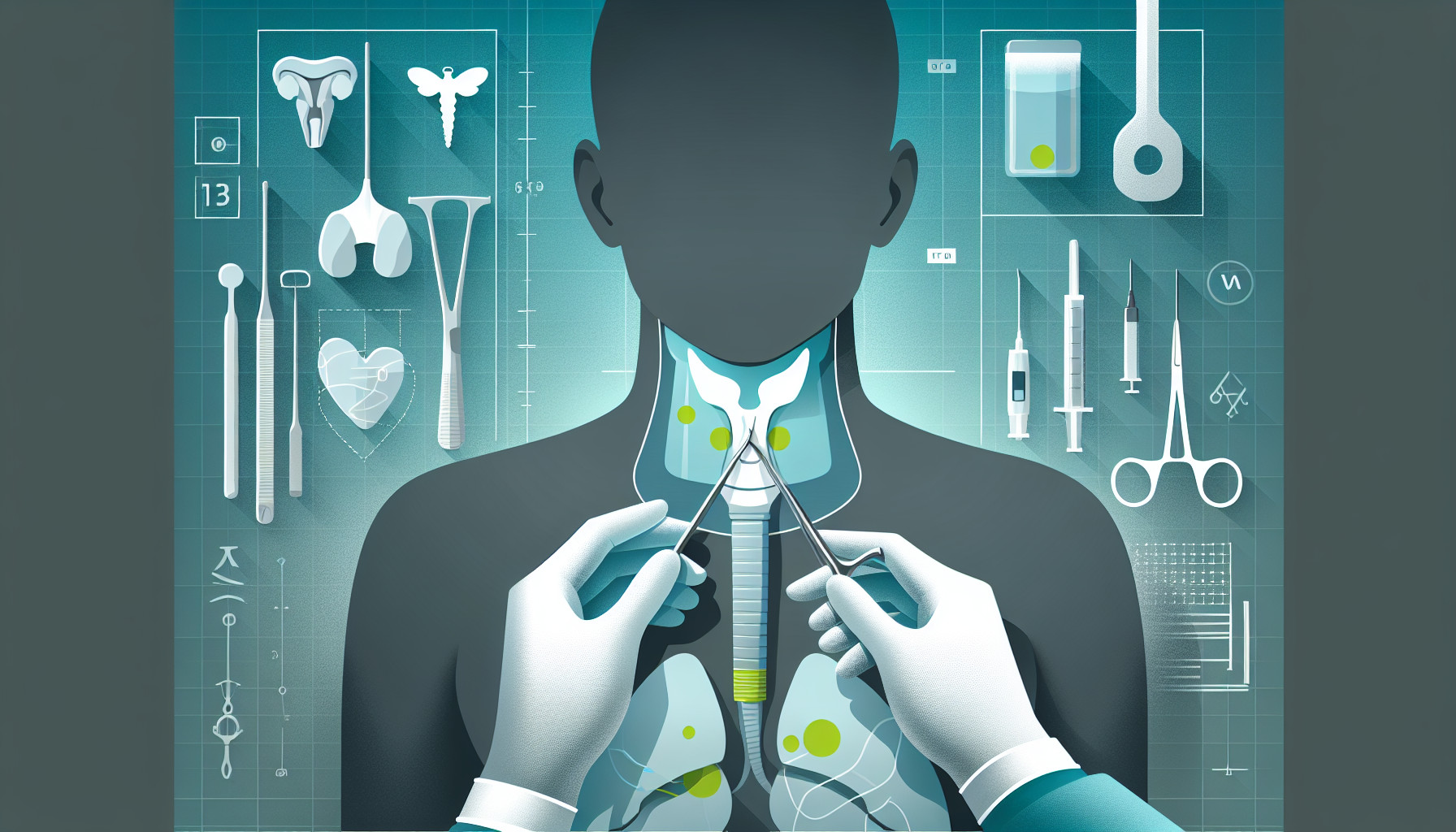Our Summary
This research study is about a new surgical method for operating on the thyroid gland. The procedure, known as transoral endoscopic thyroidectomy vestibular approach (TOETVA), is performed through the mouth and is primarily used for its cosmetic benefits.
The study reviewed 17 other studies that involved this procedure. A total of 736 surgeries were performed in these studies, some of which were complete removals of the thyroid gland and others were partial removals.
The time it took for these surgeries varied greatly, from 43 minutes to almost 6 hours. Blood loss also varied, from a very small amount to a moderate amount. In 10 cases, the surgeons had to switch to traditional open surgery. After the surgery, patients stayed in the hospital for anywhere from 1 to 10 days.
There were some complications from these surgeries. These included temporary and permanent damage to the nerves responsible for voice and swallowing, temporary dysfunction of the parathyroid glands (which control calcium levels in the body), post-surgery bleeding, fluid accumulation at the surgery site, nerve damage that affected sensation in the lower face, and infection at the surgical wound.
The study concluded that while this new method can be used to meet certain patients’ desire for less visible surgical scars, it does come with its own specific risk, namely injury to the nerves in the lower face. More research is needed to fully understand and validate this surgical method.
FAQs
- What is transoral endoscopic thyroidectomy vestibular approach (TOETVA)?
- What were some of the complications observed in the studies involving the TOETVA procedure?
- What did the study conclude about the use of the TOETVA method?
Doctor’s Tip
A doctor might tell a patient undergoing thyroidectomy to discuss with their surgeon the potential risks and benefits of different surgical approaches, including the TOETVA method. It’s important for patients to be informed and comfortable with their choice of surgery, and to have realistic expectations about potential complications and recovery time. It’s also important to follow post-operative care instructions closely and to attend all follow-up appointments to monitor healing and thyroid function.
Suitable For
Patients who are typically recommended for thyroidectomy include those with:
- Thyroid cancer: Patients with thyroid cancer may require a thyroidectomy to remove the cancerous tissue.
- Benign thyroid nodules: Patients with large or symptomatic benign thyroid nodules may undergo thyroidectomy to alleviate symptoms or prevent complications.
- Hyperthyroidism: Patients with hyperthyroidism that does not respond to other treatments may be recommended for thyroidectomy.
- Graves’ disease: Patients with Graves’ disease, an autoimmune disorder that causes hyperthyroidism, may undergo thyroidectomy if other treatments are not effective.
- Recurrent thyroid nodules: Patients with recurrent thyroid nodules that continue to grow or cause symptoms may be recommended for thyroidectomy.
- Thyroid enlargement (goiter): Patients with a large goiter that causes compression of nearby structures or difficulty breathing or swallowing may undergo thyroidectomy.
- Genetic conditions: Patients with hereditary conditions such as multiple endocrine neoplasia (MEN) or familial medullary thyroid cancer may be recommended for prophylactic thyroidectomy.
- Inconclusive biopsy results: Patients with inconclusive biopsy results or suspicious findings on imaging studies may undergo thyroidectomy for definitive diagnosis and treatment.
Timeline
Timeline before thyroidectomy:
- Patient is diagnosed with a thyroid condition such as thyroid cancer or hyperthyroidism
- Patient consults with an endocrinologist and a surgeon to discuss treatment options
- Patient undergoes pre-operative testing such as blood work, imaging studies, and possibly a biopsy
- Patient receives instructions on how to prepare for surgery, including fasting before the procedure
- Patient may need to stop taking certain medications before surgery
Timeline after thyroidectomy:
- Patient undergoes thyroidectomy surgery, either through traditional open surgery or a minimally invasive approach such as TOETVA
- Patient wakes up in the recovery room and is monitored for any immediate complications
- Patient may experience some pain and discomfort in the throat area
- Patient is monitored for any signs of complications such as bleeding, infection, or damage to surrounding structures
- Patient may need to stay in the hospital for a few days for observation and recovery
- Patient is discharged home with instructions on post-operative care, including wound care, pain management, and follow-up appointments
- Patient may need to take thyroid hormone replacement medication for the rest of their life if the entire thyroid gland was removed
- Patient may experience changes in voice, swallowing, and calcium levels in the body due to potential damage to nerves and the parathyroid glands
Overall, the timeline for a patient before and after thyroidectomy involves diagnosis, preparation, surgery, recovery, and long-term management of any potential complications or changes in thyroid function.
What to Ask Your Doctor
- What are the potential risks and complications associated with TOETVA compared to traditional open thyroidectomy?
- How experienced are you in performing TOETVA and what is your success rate with this procedure?
- What are the specific criteria that make me a good candidate for TOETVA?
- How long will the surgery take and how long is the recovery period?
- Will I need to take any special precautions or follow a specific diet/exercise regimen after the surgery?
- What are the chances of needing to convert to traditional open surgery during the procedure?
- How likely is it that I will experience complications such as nerve damage, bleeding, or infection?
- Will I need to take any medications or supplements after the surgery to manage my thyroid levels?
- How often will I need to follow up with you after the surgery for monitoring and check-ups?
- Are there any long-term effects or considerations I should be aware of after undergoing TOETVA?
Reference
Authors: Tartaglia F, Maturo A, Di Matteo FM, De Anna L, Karpathiotakis M, Pelle F, Tromba L, Carbotta S, Carbotta G, Biancucci A, Galiffa G, Livadoti G, Falbo F, Esposito A, Donello C, Ulisse S. Journal: G Chir. 2018 Sep-Oct;39(5):276-283. PMID: 30368265
